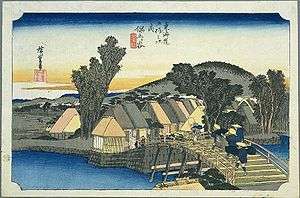Hodogaya-juku

Hodogaya-juku (程ヶ谷宿 Hodogaya-juku) was the fourth of the fifty-three stations of the Tōkaidō. It is located in Hodogaya-ku in the present-day city of Yokohama, Kanagawa Prefecture, Japan. Occasionally, it is also written as 保土ヶ谷宿.
History
Hodogaya-juku was established in 1601, and it was the western most post station in Musashi Province during the Edo period. The honjin still belongs to the same family today as the one that owned it when it was first opened. Additionally, there is a stone Buddha statue that travelers often prayed to for safety while traveling along the Tōkaidō.[1]
The classic ukiyoe print by Ando Hiroshige (Hoeido edition) from 1831-1834 depicts a bridge over a stream, with two porters carrying a closed kago towards a village on the other side. By the bridge is a soba restaurant with waitresses standing in front beckoning travellers to enter.
Neighboring post towns
- Tōkaidō
- Kanagawa-juku - Hodogaya-juku - Totsuka-juku
Minor routes, including the Kanazawa-Kamakura-dō (金沢鎌倉道), the Hachiōji-dō (八王子道) and the Ōyama-dō (大山道), branched off of the Tōkaidō at Hodogaya-juku.
References
- Carey, Patrick. Rediscovering the Old Tokaido:In the Footsteps of Hiroshige. Global Books UK (2000). ISBN 1-901903-10-9
- Chiba, Reiko. Hiroshige's Tokaido in Prints and Poetry. Tuttle. (1982) ISBN 0-8048-0246-7
- Taganau, Jilly. The Tokaido Road: Travelling and Representation in Edo and Meiji Japan. RoutledgeCurzon (2004). ISBN 0-415-31091-1
Notes
![]() Media related to Hodogaya-juku at Wikimedia Commons
Media related to Hodogaya-juku at Wikimedia Commons
- ↑ The stone Buddha and Pagoda. Yokohama City Hall. Accessed December 10, 2007.